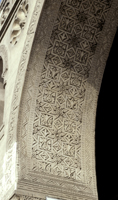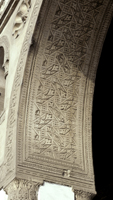There are various types of what I shall call quasisymmetry, the existence of which has been noted by others.1
I noted earlier that apparent symmetry may disappear at some level of detail. There is another application of the notion of level of detail in analyzing symmetrical designs: some compositions that have their own symmetries include elements that have different symmetries. In such cases the levels of detail are: the framework; the individual inclusions considered separately; the inclusions considered as a set (as if floating on a neutral background), and the entire framework and inclusions taken as a whole.
The carved stucco soffits of the Mosque of Ibn Ṭūlūn in Cairo (263–65/876–79), are examples of frameworks with sets of included elements. While restored, they seem to preserve their original designs.2 I consider and illustrate here only one half of each soffit, ignoring how the design is reflected at the apex of the arch, or whether it is reflected at all.

Figure 1. Mosque of Ibn Ṭūlūn, Cairo, soffit.
In the first example, the framework of the main field is formed by overlapping circles enclosing four-lobed fields. Ignoring the interlacing the framework has symmetries of reflection, translation, rotation, and glide reflection. In Washburn and Crowe's terminology this is a one-color, two-dimensional pattern. In their notation it is p4m.3 Taking into account the interlacing, the framework loses symmetry of reflection and glide reflection; it is p4.4
The inclusions considered separately (and for simplicity ignoring all the fillers except those in the circles in the centers of the four-lobed figures) all have a single symmetry of reflection along the vertical axis and no other symmetries. There are two motifs used in these inclusions (ignoring minor variations and taking a liberal view of the motifs intended for the cropped inclusions at the edges), and they alternate. Considering only the set of inclusions, there is one symmetry of reflection, along the vertical axis, and symmetries of translation along vertical, horizontal, and 45° axes, as well as symmetry of glide reflection.
Finally, considering the entire framework and inclusions taken as a whole, the soffit has only symmetries of translation along vertical, horizontal, and 45° axes. At every level of analysis the symmetries of the soffit differ.

Figure 2. Mosque of Ibn Ṭūlūn, Cairo, soffit.
I illustrate a second example for the curious reader to ponder.

Figure 3. Mosque of Ibn Ṭūlūn, Cairo, soffit.
In a third soffit, the analysis of which I abbreviate, there are three columns of full lozenges: up the center and on either side. The two columns of full lozenges at the left and right share a bevelled style filler motif that has symmetry of reflection along its long axis only; this motif is rendered in one orientation on the left and in a 180° rotated orientation on the right. However, the central column of lozenges uses several different filler motifs that are not distributed in any regular way, so the entire framework and inclusions taken as a whole has no symmetry whatsoever. I have to admit I see no artistic value in this irregularity, but such irregularities are not uncommon.
I have already pointed out that there are constructs in art that are perceived as symmetrical although they are not strictly symmetrical: they are symmetrical only when some of their details are ignored (“when you squint”). The conclusion to be drawn from the examples presented in this appendix is that it can be necessary to describe the symmetry of components of a pattern as well as the pattern as a whole in order to understand the way it was constructed. The typology of levels I have used above is: the framework considered aside from its interlacing; the framework considered with its interlacing; the enframed elements (inclusions) considered individually; the enframed elements considered as a group but without the framework; and the framework and the included elements considered together. I believe this typology will suit a large number of designs, but others can be created to suit the material to be analyzed.
1. Weyl, op. cit., pp. 8ff., discusses what might be called “generalized symmetry”, in which the symmetrical forms (he deals with human figures) are not entirely symmetrical by reflection, translation, and so on.
2. Creswell, Early Muslim Architecture, 2nd ed. v. 2, provides prerestoration photographs of the three I illustrate here: pl. 103 c, 103 b, and 104 a. The first two illustrations do not include the bottom of the field.
3. My path through the flow chart:
P. 128, “What is the smallest rotation?” 90°.
“Is there a reflection?” Yes.
“Are there reflections in lines which intersect at 45°?” Yes.
4. My path through the flow chart:
P. 128, “What is the smallest rotation?” 90°.
“Is there a reflection?” No.